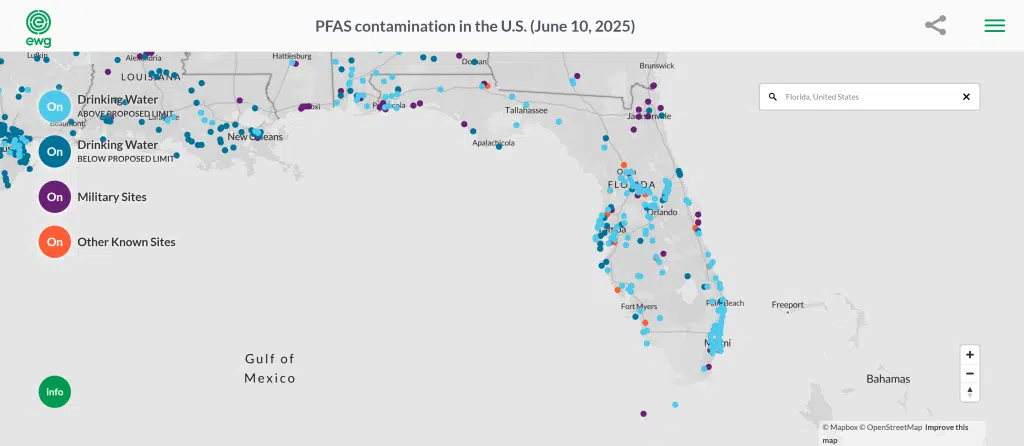- Home
- Personal Injury
- PFAS Lawsuit
- PFAS Contamination Map
- PFAS in Florida
PFAS in Florida
- Last updated: July 16, 2025
-
Contributor: nicky

I have spent months examining the growing concern over per- and polyfluoroalkyl substances (PFAS) across Florida. Many state agencies, including the Florida Department of Environmental Protection (FDEP), have confirmed that these synthetic chemicals are prevalent in drinking water supplies, soil, and even agricultural products. On April 10, 2024, the U.S. Environmental Protection Agency (EPA) released final maximum contaminant levels (MCLs) for six key PFAS, prompting an urgent response across the state.
Florida’s abundant freshwater springs, coastal aquifers, and inland groundwater reserves make the issue especially pressing. Researchers from the University of Florida found that 63% of spring vent samples contained PFAS. In more than half of these sites, multiple PFAS were detected at quantifiable levels. I have seen how these findings fuel widespread concern about PFAS Florida contamination, from aging water systems to agricultural run-off. Below, I will break down the core facts behind PFAS, describe how they end up in Florida’s environment, and explain your options if you or your family have been exposed.
What are PFAS and why are they dangerous?
PFAS are man-made chemicals that date back to the 1940s. They have been used in products like stain repellents, nonstick cookware, firefighting foams, and industrial lubricants. Because PFAS molecules resist heat, oil, grease, and water, they do not break down easily. This durability, unfortunately, means they can persist in the environment and remain in human bodies for years.
Health agencies including the U.S. EPA and the Centers for Disease Control and Prevention (CDC) are actively studying PFAS toxicity. Some studies in humans and animals have noted associations between PFAS exposure and certain cancers, thyroid problems, elevated cholesterol, and possible immune-system effects. Scientists also highlight that PFAS exposure can happen cumulatively over time. If you drink, breathe, or eat PFAS-contaminated substances daily, or if you live near a heavily polluted site, the body’s total PFAS burden can rise exponentially.
Where are PFAS found in Florida?
I have noticed that Florida’s geographic location and industrial history create multiple sources for PFAS contamination. PFAS often reach the environment through:
- Industrial discharges in areas with historical manufacturing
- Use and disposal of aqueous film-forming foam (AFFF) at airports and firefighting training sites
- Wastewater treatment plants, which typically remove less than 10% of these compounds, sending the rest back into waterways
- Leaching from landfills, where products treated with PFAS end up
- Runoff into natural springs, especially in central and northern Florida
A November 2024 study analyzed 90 water samples from 50 freshwater springs in Florida and found PFAS in nearly 70% of spring-run samples. Sites near Deltona, including Green Spring, Blue Spring, and Gemini Spring, had significantly high PFAS levels, sometimes above the EPA’s MCL of 4 parts per trillion (ppt). According to the University of Florida’s interactive map, PFAS “clusters” exist in coastal communities and central counties with older industrial or military installations.
PFAS in Florida’s drinking water
Clean drinking water is a cornerstone of public health. However, multiple studies indicate that Florida’s water systems are at risk. The University of Florida team has tracked PFAS levels using over 2,300 samples statewide, concluding that public water systems sometimes deliver water containing levels that exceed federal guidelines.
High-risk areas and water utilities
In my research, I have seen that certain parts of the state face bigger threats. Coastal municipalities where firefighting foams have been used at multiple airports or naval bases often top the watch list. Inland areas near old manufacturing hubs or landfills also rank high. The Florida Department of Environmental Protection is currently examining which public water utilities may require immediate upgrades to filtration technology.
Ongoing testing and state advisories
Florida’s Legislature is expected to adopt the new federal PFAS drinking water standard introduced by the EPA. Although the rule sets an MCL of 4 ppt for PFOA and PFOS, many utilities still rely on outdated infrastructure. The EPA estimates nationwide compliance will cost about USD 1.5 billion annually, with a share of that burden likely falling on Florida. However, the 2021 Bipartisan Infrastructure Law earmarks at least USD 9 billion for communities impacted by PFAS. Florida could receive significant funding to help local utilities upgrade processes, improve filtration, and launch additional testing.
AFFF firefighting foam and groundwater impact
AFFF is one of the most common sources of PFAS release into Florida’s groundwater. Fire departments, airports, and industrial sites have all used these foams during training and emergency response situations. Although newer formulations claim lower PFAS content, older foam stocks can seep into soil or storm drains for years if not safely disposed of. Residents living near firefighting training areas may want to consider testing their wells for PFAS contamination.
PFAS in Florida’s soil and agriculture
PFAS do not just contaminate water. These substances can accumulate in soil and even be taken up by crops or livestock. FDEP notes that investigating PFAS levels in farmland is increasingly critical. Irrigation water, treated wastewater sludge (often used as fertilizer), and runoff from industrial sites can lead to gradual buildup of PFAS in the soil. Some farmers have begun voluntary testing to see whether their produce or feed is carrying unsafe levels.
At present, the state does not have uniform guidelines outlining the permissible PFAS levels in agricultural soils, but federal and state agencies continue to evaluate the risk. I have spoken with growers who are actively investing in water-filtration systems or taking advantage of cost-sharing programs to keep potential contaminants out of irrigation lines. These measures aim to protect farmworkers, crops, and ultimately consumers.
Health effects of PFAS exposure
Health concerns over PFAS exposure revolve around both short-term and long-term impacts. Health agencies across the country have highlighted possible links to:
- Immune-system impairments, particularly in children
- Elevated cholesterol levels
- Changes in liver enzymes
- Thyroid disease and hormonal disruptions
- Certain types of cancer, including kidney and testicular
However, I have also seen varying results in the scientific literature. Some human epidemiological studies confirm higher incidences of disease in communities with known PFAS contamination, while others find only weak correlations. The CDC warns that many factors, such as genetics and lifestyle, add complexity. Without a doubt, I believe continual research is essential to fully understand how PFAS interact with human biology.
PFAS-linked diseases in Florida
Scientists are especially focused on four conditions that have shown stronger correlations with PFAS exposure. In Florida, public health officials monitor local case rates for these conditions in communities with documented contamination.
Kidney cancer
The link between PFAS and kidney cancer emerged in studies examining workers at chemical plants. These chemicals can concentrate in the kidneys, potentially causing cellular damage over time. My caution to Floridians is to be mindful of any unexplained pain or urinary symptoms if you live near a PFAS hotspot, because early detection can be crucial.
Testicular cancer
PFAS exposure has also been studied in connection to testicular cancer. This is sometimes attributed to tissue-specific vulnerabilities. Although not everyone with high PFAS exposure will face this diagnosis, the Florida Department of Health encourages men in high-risk exposure areas to pay closer attention to any unusual lumps or changes.
Thyroid disease
Because PFAS can affect hormone regulation, thyroid disorders, including both hyperthyroidism and hypothyroidism, have been noted. In Florida, I often see residents dealing with thyroid issues near contaminated springs or industrial sites. Regular check-ups and blood tests help detect problems early.
Liver damage and cholesterol changes
PFAS may prompt elevated liver enzymes and disrupt how the body manages cholesterol. Even minor exposure over many years can raise serum cholesterol levels. Florida-based health advisories, including those issued by the Department of Health Services in other states, recommend monitoring blood lipids and liver function if you suspect persistent exposure.
How Florida is responding to the PFAS crisis
I have observed multi-agency efforts to curb PFAS contamination. The EPA, FDEP, and local governments each focus on different regulatory and monitoring measures. State-level strategies in Florida often mirror federal actions but with an added emphasis on protecting unique local ecosystems.
Florida Department of Environmental Protection (FDEP) actions
FDEP oversees site investigations, manages water-quality standards, and monitors industrial permits related to PFAS. The department is expected to propose a state drinking-water rule consistent with the EPA’s 4 ppt standard by January 2025. FDEP also issues guidance on best practices for handling firefighting foams and disposing of PFAS-laden waste to reduce further environmental release.
Federal and state investigations
State and federal investigations have targeted known PFAS sources such as airports, firefighting training centers, and sewage-treatment plants. Sampling activities, including the use of specialized detection equipment, are part of an ongoing effort to map Florida’s contamination patterns. The University of Florida’s interactive map consolidates thousands of these data points, allowing the public to identify high-risk clusters.
Drinking water sampling programs
Many utilities currently offer or plan to offer free or subsidized water sampling to residents in high-risk areas. Meanwhile, the EPA’s newly established PFAS rule requires certain public systems to measure and report PFAS levels routinely. Although the upgrades needed to maintain compliance can be costly, federal infrastructure funding has been made available to speed up improvements.
Can you test your water or soil for PFAS in Florida?
If you suspect PFAS presence in your well or soil, you can arrange testing through certified laboratories. Some county health departments and water utilities partner with labs to provide kits and instructions for sample collection. The process typically involves:
- Obtaining sampling containers approved for PFAS analysis
- Drawing a water or soil sample using sterile techniques
- Labeling and shipping the sample to a certified lab
- Receiving results that show specific PFAS concentrations
Because specialized technology is required to detect PFAS down to parts per trillion, I have found it best to work with labs accredited by the National Environmental Laboratory Accreditation Program. Check with FDEP to find recognized labs and read any advisory bulletins for your region.
Do you qualify for a PFAS lawsuit in Florida?
Residents who have lived near industrial sites, used well water testing positive for high levels of PFAS, or experienced PFAS-linked health issues may have legal avenues to pursue compensation. Potential damages often center on medical costs, property-value decline, or lost wages due to serious illness.
Litigation can target manufacturers who knowingly discharged PFAS or failed to warn buyers of the associated risks. In some cases, local or state agencies might be included if they violated oversight responsibilities. If you suspect your illness or property damage is related to PFAS contamination, I encourage you to explore whether a lawsuit is viable, either individually or by joining a class-action claim.
Why choose Legal Claim Assistant
I have seen how navigating PFAS litigation can be daunting. Complex science, multiple legal parties, and the need for expert testimony require specialized knowledge. Legal Claim Assistant offers a direct path to finding experienced attorneys who are well-versed in PFAS cases. They provide:
- A free case review to determine if you qualify for compensation
- Guidance on legal deadlines for PFAS claims
- An understanding of recent state and federal PFAS regulations
- Access to national networks of environmental litigators
If you want to learn more, you can visit their PFAS Lawsuit page at Legal Claim Assistant. Additionally, they provide information about water contamination lawsuits here: Water Contamination Lawsuit and background on major PFAS manufacturers on the DuPont Lawsuit page.
Frequently asked questions (FAQ)
Below are some of the most frequent questions I receive about PFAS contamination in Florida. These answers reflect current information from federal, state, and academic sources.
PFAS problems are often concentrated around military bases, airports, and industrial sites. For instance, seven spring sites near Deltona tested above EPA’s MCL. The University of Florida’s interactive map offers local insights into high-risk areas.
If you live in another state, you might also find PFAS contamination in your area. For instance, you can see ongoing monitoring updates in Minnesota or New York, as PFAS contamination can cross state borders.
Yes. You can contact certified labs or check with your county health department to learn about testing kits. Some municipalities provide these services at reduced cost.
Florida is expected to propose adopting the EPA’s 4 ppt standard for PFOA and PFOS by January 2025, according to FDEP communications. Public water suppliers must test regularly and, if necessary, improve filtration to meet these limits.
Agricultural operations that rely on contaminated irrigation water or use biosolids with PFAS may face soil buildup of these chemicals. The state does not yet have formal PFAS limits for soils, but FDEP is investigating how farmland contamination could affect produce and livestock.
Recent studies have linked PFAS exposure to kidney and testicular cancers, thyroid disorders, liver damage, and cholesterol disruptions. However, the severity of effects can vary based on exposure duration and individual health factors.
Yes. If you suspect serious health or property damage from PFAS, you may have a claim against manufacturers or other responsible parties. I recommend connecting with Legal Claim Assistant for a free review and more detailed guidance on filing a PFAS lawsuit in Florida.
Overview PFAS contamination in the USA
Here you van find the PFAS watercontamination map of the United States. Find, state by state, where water contamination has occurred due to PFAS exposure.
- PFAS in Alabama
- PFAS in Alaska
- PFAS in Arizona
- PFAS in Arkansas
- PFAS in California
- PFAS in Colorado
- PFAS in Connecticut
- PFAS in Delaware
- PFAS in Florida
- PFAS in Georgia
- PFAS in Hawaii
- PFAS in Idaho
- PFAS in Illinois
- PFAS in Indiana
- PFAS in Iowa
- PFAS in Kansas
- PFAS in Kentucky
- PFAS in Louisiana
- PFAS in Maine
- PFAS in Maryland
- PFAS in Massachusetts
- PFAS in Michigan
- PFAS in Minnesota
- PFAS in Mississippi
- PFAS in Missouri
- PFAS in Montana
- PFAS in Nebraska
- PFAS in Nevada
- PFAS in New Hampshire
- PFAS in New Jersey
- PFAS in New Mexico
- PFAS in New York
- PFAS in North Carolina
- PFAS in North Dakota
- PFAS in Ohio
- PFAS in Oklahoma
- PFAS in Oregon
- PFAS in Pennsylvania
- PFAS in Rhode Island
- PFAS in South Carolina
- PFAS in South Dakota
- PFAS in Tennessee
- PFAS in Texas
- PFAS in Utah
- PFAS in Vermont
- PFAS in Virginia
- PFAS in Washington
- PFAS in West Virginia
- PFAS in Wisconsin
- PFAS in Wyoming
Related Article

What Philips CPAP Machines Are Recalled and Why

